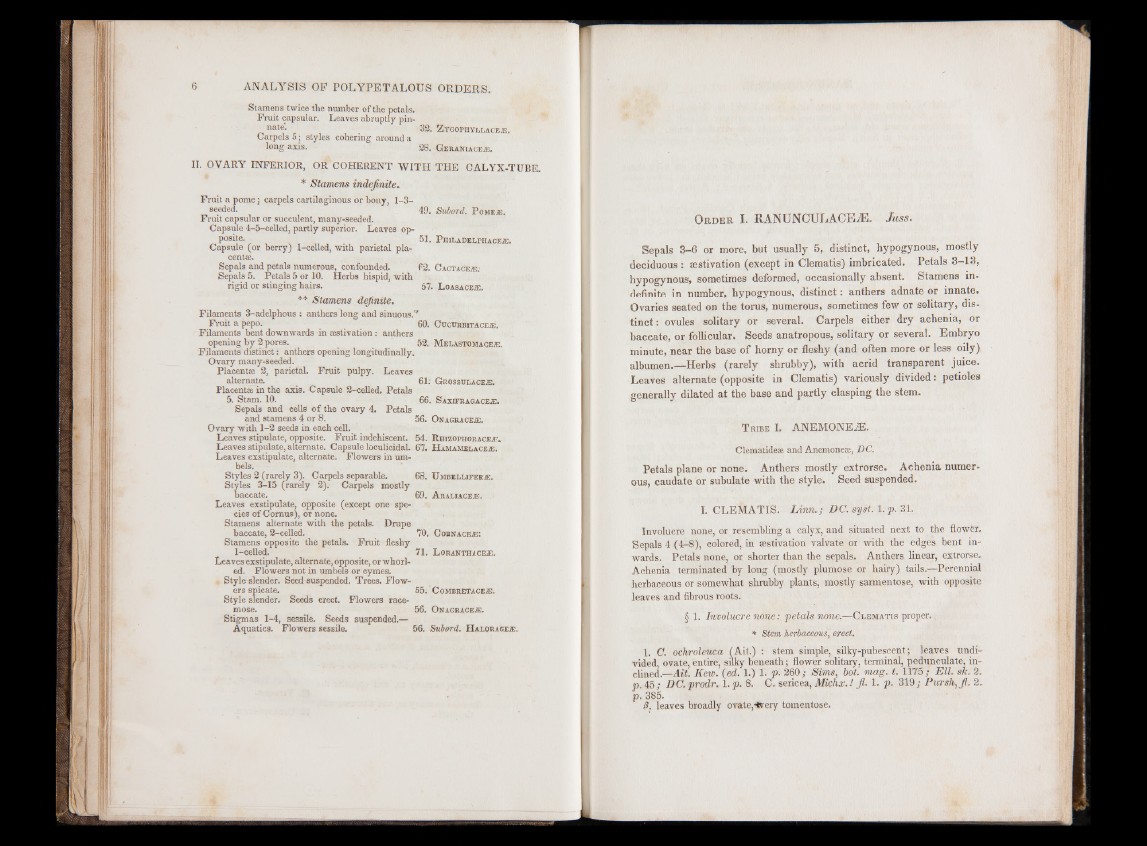
Stamens twice the number of the petals.
Fruit capsular. Leaves abruptly pinnate.
Carpels 5; styles cohering around a
long axis.
32. Z ygophyllace®.
28. Geraniace®.
II. OVARY INFERIOR, OR COHERENT WITH THE CALYX-TUBE.
* Stamens indefinite.
Fruit a pome; carpels cartilaginous or bony, 1-3-
seeded.
Fruit capsular or succulent, many-seeded.
Capsule 4-5-celled, partly superior. Leaves opposite.
Capsule (or berry) 1-celled, with parietal pla-
centse.
Sepals and petals numerous, confounded.
Sepals 5. Petals 5 or 10. Herbs hispid, with
rigid or stinging hairs.
49. Subord. P ome®.
51. P hiladelphace®.
F2. Cactace®;
67. L oasacejE.
** Stamens definite.
Filaments 3-adelphous : anthers long and sinuous.“'
Fruit a pepo. 60. Cucurbitace®.
Filaments bent downwards in aestivation: anthers
opening by 2 pores. 52. Melastomace®.
Filaments distinct: anthers opening longitudinally.
Ovary many-seeded.
Placentae 2, parietal. Fruit pulpy. Leaves
alternate. 61: Grossclace®.
Placentae in the axis. Capsule 2-celled. Petals
5. Stam. 10. 66. Saxifragace®.
Sepals and cells of the ovary 4. Petals
and stamens 4 or 8. 56. Onagrace®.
Ovary with 1-2 seeds in each cell.
Leaves stipulate, opposite. Fruit indehiscent. 54. Rhizophorace®.
Leaves stipulate, alternate. Capsule loculicidal. 67. H amamelace®.
Leaves exstipulate, alternate. Flowers in umbels.
Styles 2 (rarely 3). Carpels separable. 68. Umbellifer®.
Styles 3-15 (rarely 2).' Carpels mostly
baccate. 69. Araliace®.
Leaves exstipulate, opposite (except one species
of Cornus), or none.
Stamens alternate with the petals. Drupe
baccate, 2-celled. 70. Cornace®:
Stamens opposite the petals. Fruit fleshy
1-celled, 71. L oranthace®.
Leaves exstipulate, alternate, opposite, or whorl-
ed. Flowers not in umbels or cymes.
Style slender. Seed suspended. Trees. Flowers
spicate. 55. CombretAce®.
Style slender. Seeds erect. Flowers racemose.
56. Onagrace®.
Stigmas 1-4, sessile. Seeds suspended.—
Aquatics. Flowers sessile. 56. Subord. H aloraoe®.
Or d e r I. RANUNCULACEiE. Juss.
Sepals 3 -6 or more, but usually 5, distinct, hypogynous, mostly
deciduous : aestivation (except in Clematis) imbricated. Petals 3 -1 3 ,
hypogynous, sometimes deformed, occasionally absent. Stamens indefinite
in number, hypogynous, d istin ct: anthers adnate or innate.
Ovaries seated on the torus, numerous, sometimes few or solitary, distinct
: ovules solitary or several. Carpels either dry achenia, or
baccate, or follicular. Seeds anatropous, solitary or several. Embryo
minute, near the base o f horny or fleshy (and often more or less oily),
albumen.—Herbs (rarely shrubby), with acrid transparent juice.
Leaves alternate (opposite in Clematis) variously divided: petioles
generally dilated at the base and partly clasping the stem.
T ribe I. ANEMONE.ZE.
Clematideae and Anemones, DC.
Petals plane or none. Anthers mostly extrorse. Achenia numerous,
caudate or subulate with the style. Seed suspended.
I. CLEMATIS. Lin n .; DC. syst. 1 .p. 31.
Involucre none, or resembling a calyx, and situated next to the flower.
Sepals 4 (4-8), colored, in aestivation valvate or with the edges bent inwards.
Petals none, or shorter than the sepals. Anthers linear, extrorse.
Achenia terminated by long (mostly plumose or hairy) tails.—Perennial
herbaceous or somewhat shrubby plants, mostly sarmentose, with opposite
leaves and fibrous roots.
§ 1. Involucre none: petals none.—C lematis proper.,
* Stem herbaceous, erect.
1. C. ochroleuca (Ait.) : stem simple, silky-pubescent; leaves undivided,
ovate, entire, suky beneath; flower solitary, terminal, pedunculate, inclined.—
Ait. Kew. (ed. 1.) 1. p. 260; Sims, bot. mag. t. 1175; Ell. sk. 2.
p. 45 j DC. prodr. 1. p. 8. C. sericea, Michx.! fi. 1. p. 319; Pursh,fi. 2-
p. 385.
i3. leaves broadly ovate,"»very tomentose.